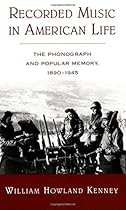Read Recorded Music in American Life: The Phonograph and Popular Memory, 1890-1945 by William Howland Kenney Online
[William Howland Kenney] ↠ Recorded Music in American Life: The Phonograph and Popular Memory, 1890-1945 ↠ Read Online eBook or Kindle ePUB. Recorded Music in American Life: The Phonograph and Popular Memory, 1890-1945 A lot here to interest the lay person and academic Kenneth Baake Kenney's book offers many intriguing insights that are accessible to those of us who are not experts in the history of the phonograph and American culture. I was fascinated to read about the early industry's angst over whether to offer popular music "to the masses" or to uphold a highbrow musical aesthetic for "the classes" through opera and Western art mu]

| Title | : | Recorded Music in American Life: The Phonograph and Popular Memory, 1890-1945 |
| Author | : | |
| Rating | : | 4.56 (995 Votes) |
| Asin | : | 0195171772 |
| Format Type | : | paperback |
| Number of Pages | : | 288 Pages |
| Publish Date | : | 2014-06-13 |
| Language | : | English |
A lot here to interest the lay person and academic Kenneth Baake Kenney's book offers many intriguing insights that are accessible to those of us who are not experts in the history of the phonograph and American culture. I was fascinated to read about the early industry's angst over whether to offer popular music "to the masses" or to uphold a highbrow musical aesthetic for "the classes" through opera and Western art mu
This is a valuable and useful contribution to the study of American life."--Sam Brylawski; Motion Picture, Broadcasting, and Recorded Sound Division; Library of Congress"At last someone has attempted to place the phonograph industry in the context of America's cultural life. This book provides the first systematic attempt at integrating the entertainment medium broadly into twentieth-century American life makes claims that have been in need of debate for some time now."--Victor Greene, University of Wisconsin-Milwaukee"A fascinating exploration of the topic and addition to the literat
era"--from the formative early decades in which the giants of the record industry reigned supreme in the absence of radio, to the postwar proliferation of independent labels, disk jockeys, and changes in popular taste and opinion. William Howland Kenney offers a full account of what he calls "the 78 r.p.m. By examining the interplay between recorded music and the key social, political, and economic forces in America during the phonograph's rise and fall as the dominant medium of popular recorded sound, he addresses such vital issues as the place of multiculturalism in the phonograph's history, the roles of women as record-player listeners and performers, the belated commercial legitimacy of rhythm-and-blues recordings, the "hit record" phenomenon in the wake of the Great Depression, the origins of the rock-and-roll revolution, and the shifting place of popular recorded music in America's personal and cultural memories.Throughout the book, Kenney argues that the phonograph and the recording industry served neither to impose a preference for high culture nor a degraded popular taste, but rather expressed a div
He is also a jazz clarinetist and the author of Chicago Jazz: A Cultural History (OUP, 1993).. William Howland Kenney is Professor of History and American Studies at Kent State University
Download Recorded Music in American Life: The Phonograph and Popular Memory, 1890-1945
Download as PDF : Click Here
Download as DOC : Click Here
Download as RTF : Click Here
